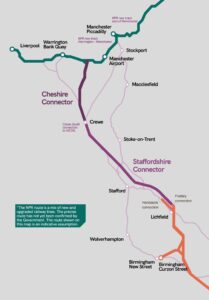A new proposal for connecting the Midlands and the North West – securing economic growth and prosperity
Earlier this month the Mayors of Greater Manchester and the West Midlands revealed the results of a review into the role of enhanced connectivity in catalysing growth, skills, and jobs across their city-regions, and to explore opportunities for greater private sector involvement in delivering and financing new solutions.
This review was chaired by infrastructure expert Sir David Higgins and led by NWBLT member; Arup alongside a private sector consortium of Addleshaw Goddard, Arcadis, Dragados, EY, Mace and Skanska.
 The report concludes that the private sector must play a new role in delivering and financing infrastructure projects and that a new rail line connecting Lichfield to High Legh is a golden opportunity for the West Midlands and the North West.
The report concludes that the private sector must play a new role in delivering and financing infrastructure projects and that a new rail line connecting Lichfield to High Legh is a golden opportunity for the West Midlands and the North West.
The Report calls for the new government to:
• Establish a Steering Group between the private sector, combined authorities and central
government to drive forward development of an ‘at pace’ feasibility study and technical
analysis over the next six months focused on:
o Working with the newly established British Infrastructure Council, the government
should convene global private sector investors to attract investment into this critical link. This is a golden opportunity to reposition the UK as a nation open to institutional infrastructure investment;
o Undertaking further financial, commercial, and economic analysis to develop a more
detailed investment prospectus for the private sector, and to optimise value for money
for the public sector;
o Advance the technical solution, working closely with industry stakeholders; and
o Developing an appropriate governance structure to take the project forward.
Critically we need to time to get this right and support from the Government to work with our
consortia, to develop this concept further and build on the work we have done to date. The
government could help the private sector advance technical and commercial solutions by:
o Maintaining ownership of the current landholdings on the former Phase 2A route
from Handsacre to Crewe whilst this work is underway;
o Reinstituting safeguarding for the land not-yet-acquired; protecting and prolonging
existing planning powers; and maintaining flexibility to reincorporate the Crewe to
High Legh segment into the repurposed NPR Hybrid Bill while a new solution is
finalised and agreed.
• To formally consider the network wide benefits of this proposition alongside proposals for
enhancing east-west connectivity in the North and the economic benefits this would bring to
the whole of the UK.
The model for the MNWRL outlined in the review has been created with the following four principles in mind:
1) Affordability – Reduces pressure on finite Government capital budgets and overall debt,
enabling greater quantities of infrastructure to be delivered in less time.
2) Cost Control – With overrun risk appropriately transferred, the contractor is better incentivised to drive down cost during design and construction. Costly variations and stop-starts can also be avoided.
3) Timeline – Rail projects with more private sector involvement are typically delivered faster.
This not only brings forward benefits but also revenue – and it mitigates cost inflation impacts.
4) Risk Management – Carefully structured contracts struck early in design development allow
risks to be identified and controlled, incentivising good behaviours around delivery to quality,
time and budget.
The Midlands – North Rail West Rail Link has the potential to connect towns and cities such as Leeds and Bradford, which is a critical connection for enhancing capacity for passengers and freight in the UK.
The report echoes findings of the recently published review from Juergen Maier, NWBLT Life President, commissioned by the Labour Party on Rail and Urban Transport. It backed the case for connecting the Midlands and the Northwest with a new line, warning the M6 corridor would collapse within a decade if no action is taken.
The review found that ‘doing nothing’ on this corridor is not a viable option, from either economic or operational perspectives.
The team assessed various options, which included doing nothing, bare minimum upgrades and a new rail link. It is envisaged the new rail line will substantially reduce costs from the previous HS2 scheme through lower design speeds, ballasted track, UK rather than European standard cross sections, and simplified interfaces with the existing rail network.
The review team analysed these concepts through ‘traditional’ criteria such as costs, benefits, and
deliverability finding that the new line has the potential to deliver roughly 85% of the benefits of HS2 Phase 2, at a fraction of the costs (c.60-75%).
The project could deliver the transformational outcomes in capacity and connectivity that the original HS2 line would have delivered (equivalent seat numbers and train frequencies), with only marginally slower journeys (approximately 15 minutes longer on the London-Manchester route – which is still 30 minutes faster than today’s services).
The team also found that a new line is the only suitable option for attracting private finance. It is also thought that it could also save the taxpayer £2bn on costs from the HS2 Phase 2 cancellation through re-use of much of the land, powers, and design work that has already been secured through public investment.
Additionally, the creation of a new rail link between Birmingham and Manchester will move some passenger services to this new line, opening additional freight paths on the West Coast Main Line – the most heavily-used freight corridor in the nation. This will greatly contribute to the Government’s target of 75% rail freight growth by 2050, a key pillar in reducing carbon emissions from transport.